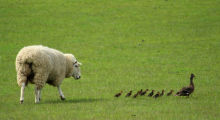Insights Into Duckling Survival & Female Mallard Brooding Behavior
- 13/06/2016
Southland Fish & Game Officer Erin Garrick has received top marks for her thesis towards a Masters in Wildlife Management on Duckling Survival & Habitat Selection of Brood-Rearing Mallard Females.
 Erin’s work, forming part of Fish & Game’s major mallard telemetry (tracking) project, provides valuable information for hunters as well as for Fish & Game as managers of the game bird resources.
Erin’s work, forming part of Fish & Game’s major mallard telemetry (tracking) project, provides valuable information for hunters as well as for Fish & Game as managers of the game bird resources.
She has summarised her findings:
Southland has long been recognised for its duck population, and the associated buzz around the district during the first weekend in May!
However, the combination of several poor mallard breeding seasons in a row, and in response to hunters concerns about the struggling North Island population, Southland Fish and Game Council funded a national mallard research project. I was fortunate to have my Master’s research funded as part of this wider project.
The Southland Council had expressed concern about continual dairy conversions and the associated changes in pasture management that might affect duckling survival. Consequently, for my research I focused on female habitat selection and factors that might impact on duckling survival.
Top right: Peaceful co-existence…a mallard mum and ducklings share space in a Southland paddock. Ducklings can be spotted quite easily in those short-grass sheep pastures.
In terms of pasture management, I found that duckling survival is comparable between dairy and sheep/deer pastoral grazing systems. This is good news for mallards in Southland, as we’ve seen much of our landscape converted to dairying systems. However, first and foremost, brood-rearing females in Southland are selecting for ‘unmanaged habitat,’ in other words, everything that is not pasture (hedgerows, shelterbelts, rank grass). This may not seem like an unexpected result, but alarmingly, these types of habitat are associated with lower duckling survival.
In our landscape, these habitats are typically thin and linear in configuration, creating ideal travelling corridors for predators. While broods may feel safe and protected tucked up in a hedgerow, predators that rely on their olfactory senses to track prey can easily run along the downwind side of these strips and pick up the scent of literally, a ‘sitting duck.’
Duckling survival is higher, I found, when broods are located further from sources of anthropogenic disturbance (human impact on the environment - such as houses, sheds, roads) and when broods travel shorter distances. I found that the presence of ephemeral water (short-lived bodies of water) during the first ten days of a duckling’s life, had a huge impact on survival. For Southland, cumulative duckling survival to 30 days of age without ephemeral water present was only 11% for broods raised by yearling females, compared to 26% for broods raised by adult females. However, with the presence of ephemeral water, duckling survival dramatically increased to 28% for broods raised by yearling females, and 46% for broods raised by adult females. Initially, ducklings require a high protein food source, which is readily available in ephemeral water, particularly in the form of earthworms that are forced to the surface. This may be why Southland is recognised as a duck factory, and as duck enthusiasts, we shouldn’t be complaining about the weather!
APPLYING THE LESSONS LEARNT
Firstly, managers can improve habitat for brood survival by not installing sub-surface drainage through pastures so as to allow temporary bodies of water to form during wet periods, or through the development of more seasonal wetlands.
Greater benefit would be realized if habitat enhancement was undertaken further from human impact – houses, roads and the like.
Managers may want to consider increasing patch size of nesting cover, thus reducing predator hunting efficiency, further improved by predator dilution when combined with methods of predator control. However, more research needs to be undertaken on the predator guild impacting on mallard females and broods and the associated specific habitat features.
Read more here.